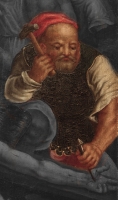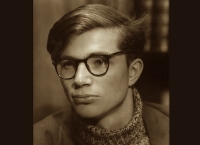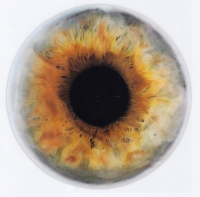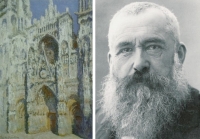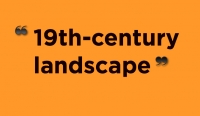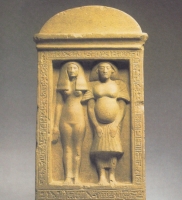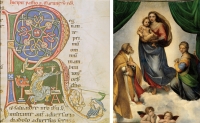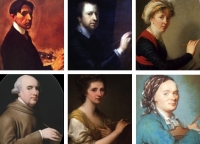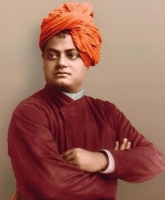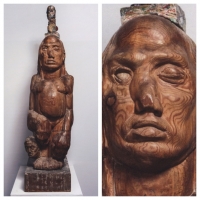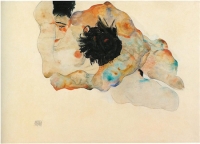21 May 2017
Art’s Timelessness
One of the exciting changes that can happen to you with an EPPH perspective is to discover that we all have the ability to see links between very different images. And the ways we do that are so far removed from conventional understanding that the
26 Mar 2015
Ssh! The Secret of Picasso’s Ear
Ears make sense as one of the five: touch, taste, sight, sound and smell. But who thinks about Picasso's ears? We mostly remember his eyes: deep, dark and powerful. Yet he himself - as I don't think has been noted before - seems to have been very
25 Mar 2015
Wisdom, Art and a Cat
I'm always on the lookout for written expressions of the basic ideas about visual art conveyed on EPPH. Here's one that backs up the concept that art and the practice of it leads to wisdom. A beautiful old Irish poem, now known as Pangur Bán af
20 Mar 2015
Whose God is on the dollar bill?
Art is too often seen as a literal representation of the artist's own small, physical world. The idea that it uses metaphoric language to express much larger, eternal truths shared by all mankind is seldom realized. The same happens with the dol
05 Mar 2015
Picasso runs his fingers through her hair
No doubt in life Picasso did run his fingers through his girlfriend's hair. In the drawing (left) from 1906 he did so too, turning an image of Fernande into a representation of himself. He might have learnt the method from any number of artists
26 Feb 2015
Art in Search of Self-Knowledge
One of the great shibboleths of art history is that High Renaissance masters depicted the exterior world. Few, of course, doubt that landscapes and portraits represent exterior nature. EPPH, on the other hand, argues that all scenes in art are i
29 Dec 2014
For how long have we read the Bible literally?
I learnt an astonishing fact today.1 The habit of reading the Bible as though it is historically true (especially the New Testament) started during the Protestant Reformation which began in 1517 and lasted more than a century. For the first 1,50
02 Dec 2014 | 11 Comments
Your Go: Explain this picture!
OK, readers, this a chance to practice your own powers of perception and interpretation before I comment:
Explain below what this Crucifixion scene might mean and the oddity of Christ’s loincloth. I am drawing attention to that
08 Nov 2014
3 Practical Ways to Understand Art
How can museum visitors and art lovers interpret art for themselves without having the specialized knowledge of experts? It is easier than you think and within the grasp of many. The key is not in books but experience. And that would have been tru
30 Oct 2014
An Artist’s Path to Certainty
How does a great artist know he is on the right track before being recognized as canonical? Van Gogh, for example, knew his own importance despite commercial and critical failure; Picasso was convinced at a very young age. The answer, I believe,
24 Oct 2014
Science, Religion and Art: Einstein on the Inner Tradition
Perhaps the most difficult part of understanding art is the Inner Tradition, the path that links not only all the world’s major religions but science, literature and music too. Religious believers strongly attached to a particular creed are un
06 Oct 2014 | 1 Comments
Dürer, Titian, Art and Blasphemy
For those who have trouble - I certainly did - understanding how artists like Dürer (top) and Titian (below) could have portrayed themselves as Christ, here is a poem attributed to an 11th-century spiritual master of the Greek Orthodox Church
03 Sep 2014 | 1 Comments
Leonardo’s Skull Rocks
Art is visual which means, contrary to a lot of theoretical discourse, so are its secrets. And if you train your eyes to search for similarity rather than difference, you'll be amazed at what you can discover.
Few paintings have b
20 Aug 2014
The Craftsman’s Christ
This is a scene by an unknown 16th-century artist, probably Flemish, at a time when artisanal effort was admired not just for the perfection of the end-product but for the artisan’s closely-guarded knowledge of materials. Wood, stone, minerals,
28 Jul 2014 | 4 Comments
Ego’s Poetic Powers
EPPH has long argued that artists mute their ego to gain access to poetic depths. Yet in the passage below Colin Wilson, the English philosopher and novelist who died last year, describes a more balanced understanding in which poets identify wit
05 Jul 2014 | 1 Comments
Why art’s meaning repeats
There is never any new content in art [see definition below].1 Art’s meaning is true. Truth is constant. Thus, it must always be true. And it must always have been true, at least since the development of mankind. So, if art expresses fundament
25 Jun 2014 | 2 Comments
Is self-representation self-centered?
(On vacation. A re-post from last summer)
The practical and philosophical issue of whether figures in art depict the artist or the apparent character is well expressed by two different translations of the same text in a Upanishad. The p
09 May 2014
Naming Names
Names limit. We need them as shorthand, to avoid explaining everything from scratch. But they deceive, confuse and blind. I'm talking about names in everday life and how, once used, they pigeon-hole the person, the object, the idea or whatever i
01 May 2014 | 1 Comments
An Intriguing Self-portrait, c.1345 BC
One of the earliest surviving self-portraits from antiquity is that of Bak, chief sculptor to the Egyptian pharaoh Akhenaten. It is beautifully preserved in Berlin (above) and is very intriguing given Western art history’s traditional descript
23 Apr 2014
Raphael, a Brother, and an Initial Idea
Art, according to EPPH, is esoteric, a visual primer on the Inner Tradition created by women and men every bit as spiritual as a robed monk, often more so. Indeed in the Middle Ages most artists were clerics or monks working in the scriptorium o
18 Feb 2014
Art’s Purpose
To become like God (ie, gain access to Wisdom) has long been the principal goal of all who practice inner-focused spirituality. The group includes not only monks and nuns in cloistered communities but spiritual seekers in the wider world as well
05 Jan 2014 | 2 Comments
How God became Woman
Art is so pregnant that it can take months for its hidden meaning to emerge in your thought. That’s why we try to enter the artist's mind, not just through social customs and the religious dogma of a period but also through art's own culture w
15 Dec 2013
Your Self is My Self
You can find wisdom within all major religions (and an awful lot of nonsense too). Some of the Eastern traditions which openly concentrate on training the mind and looking inwards are particularly useful for understanding art in all media. That�
14 Dec 2013
Winking in Art
Russian artists in the early 20th century turned to the West to absorb the latest trends happening in Paris. That’s the conventional story. Yet, little known, at the same time they were also turning eastwards towards Siberia and Russia’s ori
15 Nov 2013
Can All in Art be One?
If new visitors to EPPH wonder how landscapes, still-lifes, portraits and scenes of battle can all have a single theme, think not whether the wide variety of art can really be a single subject but whether the proposed subject, a view of the soul
12 Nov 2013
Where on earth is the Kingdom of Heaven?
Occasionally, while studying art, I achieve a breakthrough quite unlike my normally slow and incremental progress. One of those moments was discovering that key words and phrases in the Bible and other esoteric texts intentionally mislead, allow
31 Oct 2013
A Sioux Story on Creation
Every painter paints himself is not just an expression of a poetic method but an insight into the nature of reality. That’s why it’s so important. You can only see in front of you what you already know or feel inside you. Thus, we too p
14 Oct 2013
The Error of Art History
Yesterday I wrote about how some errors make the world interesting and beautiful. This one does not.
Read the Journals of Ralph Waldo Emerson, who rarely saw great art, and you will learn about it on every page because the truths
13 Oct 2013
Higgs Boson and Mistakes
So, not long after the discovery of the Higgs boson and half a century after they predicted its existence, Higgs and Englert win the Nobel Prize in Physics. I don't often relate to advances in science but this one's a biggie. Last year, on news
09 Oct 2013 | 1 Comments
Artist Crucified in his Studio
No-one you know thinks of themself as Christ which may be why most people find it so impossible to believe that artists do. My continual harping on this theme can sound like madness. One new reader, clearly dedicated to her Church, complained vo
The EPPH Blog features issues and commentary.













